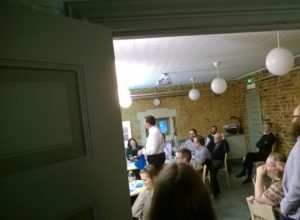I thought it fitting for my first post to explain the name of the blog where I’ve chosen to locate my writings. Names are important, after all: they identify our essence, our substance in a manner much more present than a simple label can. They can tell us where we have been, and sometimes even where we are going—or perhaps where we want to go. In all of my intellectual, spiritual, and cultural wanderings thus far, I have found a striking pattern in what catches my fancy and what grants me an abundance of life in the here and now: I love things that are old, things that bear upon themselves the weight of time and maturity.
I find myself constantly ruminating on Tolkien’s line, “the old that is strong does not wither.” There are words and ideas and great works of art that have stood the test of time precisely because of the strength and vigor they possess innately. They spoke to the culture in which they were fashioned, and they still speak now. But I also find myself in love with the new. The pristinity of the new, its sense of progress and growth, is equally intoxicating for different reasons. As a composer, I write what I consider to be new music, but I am constantly drawn to very old music for inspiration and study. What does one call this state of loving both the old and the new?
When I read an old text like The Dream of the Rood, I feel within myself a strange longing, a nostalgia for a time I’ve never known and a place I’ve never been. What do you call an experience, brand new to you, that brings up feelings reminiscent of old, fond memories? This paradox of an experience deserves a name, and thus I call it Neue-, the German word for “new”, a language I am quite fond of, and –stalgia, from our word for a bittersweet or wistful memory of times past. This portmanteau*, Neuestalgia, defines for me what is probably the most poignant element of my intellectual wanderings.
When I first encountered the beautiful St. Joseph’s university parish on SUNY Buffalo’s south campus, I was consumed by its serenity, by the sheer divine reverence experienced within its walls. It was architecture that worshipped, largely because it had a direct connection to over a thousand years of similar constructions in Europe. Though St. Joseph’s is quite new in comparison, it evoked the grandeur and mystique of ancient chapels and churches. Still, I am not accustomed to worship in such a place, whether from childhood or my own faith tradition. Yet there was in me a strange longing to be better in touch with the timelessness I felt in the very stones of the church.
I felt similarly when I began to listen in earnest to Byzantine chant, especially that of the Serbian and Georgian traditions, as well as the Roman Catholic Sarum chant, the closest relic we have of the days of insular liturgical music among the British Isles. There is something in this music that calls to me, as if I knew it before, somehow.
My only explanation for these longings, for this Neuestalgia, is that it reflects a homesickness for a world I have not yet known: for Heaven (or perhaps, more precisely, for the New Earth that will accompany it). I feel out of sorts here on this earth because it is not my home and never was intended to be. At its very best, at the height of its beauty, this world is only the merest reflection of what is to come. That is why ancient and beautiful things make me long for somewhere else.
The best things of this world point us to the next, and when we experience them in the here and now, we are reminded constantly of the wonders we have before us. This blog, Neuestalgia, will serve as a record of my wanderings and a resonating chamber for my reflections on them. By better understanding why I wander, why I love both the old and the new, I hope to anticipate that glorious future by living better in the present.

St. Joseph’s Parish on SUNY Buffalo’s South Campus


